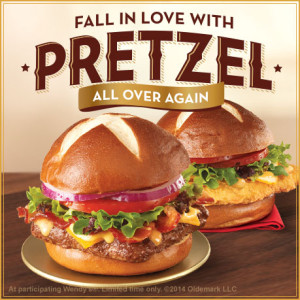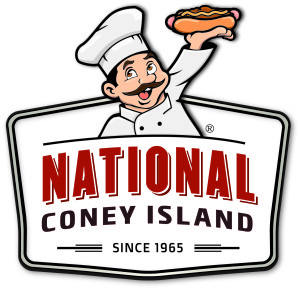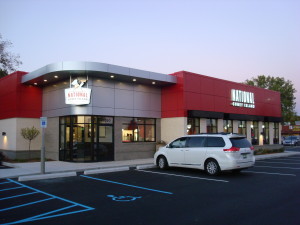Call 303-808-4680
 Fast forward to 2014: While McDonald’s, Wendy’s, and Burger King continue to be the segment’s top players, competition is fiercer than ever. Within the scope of limited service, fast casual is the only category seeing overall growth, according to numerous industry analysts. And though that certainly doesn’t signal any permanent decline or end for fast food, it may require traditional quick serves to adapt at a quicker pace than before.
Fast forward to 2014: While McDonald’s, Wendy’s, and Burger King continue to be the segment’s top players, competition is fiercer than ever. Within the scope of limited service, fast casual is the only category seeing overall growth, according to numerous industry analysts. And though that certainly doesn’t signal any permanent decline or end for fast food, it may require traditional quick serves to adapt at a quicker pace than before.
Coming in at No. 4 on our QSR 50 list, Wendy’s provides a case study for just how a brand with deep roots can attempt to change with the times. When CEO Emil Brolick came aboard in 2011, he declared that the company would make moves to be a viable competitor to fast casuals like Five Guys Burgers & Fries. That goal culminated in a brand refresh that’s touched everything from the menu and marketing to store design and employee uniforms. The LTO pipeline at Wendy’s continues to churn out crowd pleasers like the game-changing Pretzel Bacon Cheeseburger, and is complemented by TV advertising aimed at the industry’s must-have demographic: Millennials.
“Wendy’s is a brand that challenges the status quo. Dave Thomas embodied the idea of never settling and always striving for better—of being ‘a cut above,’” says John Barker, chief communications officer and senior vice president of The Wendy’s Company, in an email to QSR. “We continue that tradition today, but in a contemporary way.”
Early indicators show Wendy’s revamp could be working—the Freckled Lady saw systemwide sales growth in 2013 for the third year in a row since a 2.26 percent decline in 2010. But some industry experts remain weary of the brand’s strategy.
“They’re saying they want to be ‘a cut above,’ but a cut above what?” says Warren Ellish, founder of Ellish Marketing Group, which has served several big quick-serve players. “They don’t know what to stand for. They’re getting looser instead of more focused.”
Whichever way you slice it, Wendy’s is certainly making waves. And while only time will tell how much success the brand truly sees, company executives are sticking to their guns in the hopes that they’ve found the right formula to excel in today’s stagnant quick-service landscape and beyond.
The LTO bandwagon
 In the eyes of some industry experts, Wendy’s struck gold when it began innovating its bread. It all started with the reprise of a popular LTO, the Flatbread Grilled Chicken line, in September 2013, and picked up real momentum with the release of the Pretzel Bacon Cheeseburger and Pretzel Pub Chicken later that fall.
In the eyes of some industry experts, Wendy’s struck gold when it began innovating its bread. It all started with the reprise of a popular LTO, the Flatbread Grilled Chicken line, in September 2013, and picked up real momentum with the release of the Pretzel Bacon Cheeseburger and Pretzel Pub Chicken later that fall.
“That’s a good example of taking a category that’s stale—no pun intended—and really changing it up in that [quick-service] market,” says chef Adam Moore of Charlie Baggs Culinary Innovations, a menu development and consulting firm for the foodservice industry. “When it comes to Wendy’s and comparing them to other [quick serves] out there, what I’ve found with them is that they’re more open to menu innovation, their focus being on fresh—from fresh fries to their preparations and types of ingredients.”
Wendy’s followed up with the Bacon Portabella Melt burger on a brioche bun in November 2013 and the Mediterranean-inspired Ciabatta Bacon Cheeseburger in January. All of these LTOs hit on sophisticated flavor profiles intended to resonate with the Millennials who are demanding that of quick serves, allowing Wendy’s to stick a premium price tag on premium menu items. But some experts express concerns that the fleeting nature of LTOs, despite the fact that they build immediate buzz, isn’t a beneficial strategy in the long run.
“What happens a lot in the restaurant industry is that a brand tries to be everything for everybody, … adding something with the hopes it’ll extend their customer base,” Ellish says. “But typically what happens when you keep adding items is you don’t increase your reach, but you decrease the quality and performance of what you’re doing.”
Ellish adds that LTOs can also alienate core customers if not balanced with permanent menu item growth. Beyond that, some industry experts also say Wendy’s premium LTOs can be seen as a sign of defeat against the fast-casual segment and won’t resonate with consumers because of the perception surrounding all fast food.
“By doing some more upscale items, [Wendy’s] is telling everyone, ‘Yeah, these upscale guys are eating into our market share, and we need to do what they’re doing.’ It’s just tough because customers won’t give Wendy’s credit for [upscale items],” says Dan Rowe, CEO of Fransmart, a development group with several quick-service clients.
While Wendy’s hasn’t taken steps to incorporate popular premium LTOs or new sandwiches into the permanent menu, it has focused on revamping its salad platform, replacing low performers with more sophisticated options. Two chef-inspired salads, the Asian Cashew Chicken Salad and BBQ Ranch Chicken Salad, replaced the Baja Salad and the Chicken BLT Cobb in early March.
“People are seeking innovation, but usually it takes going back to the basics and then using seasonings or flavor profiles that are unfamiliar to the general mainstream, like in the Asian Cashew Chicken salad,” Moore says.
Wendy’s executives saw these permanent offerings, along with a seasonal Strawberry Fields salad that returned to the menu in June, as key items to target Millennials with distinct, bold flavors, Barker says. Both new salads also have 50 percent less fat, 29 percent less sodium, and 61 percent less saturated fat than the discontinued salads.
“With something like the higher-end salads, they’re giving people a way to get satisfaction within a category that has a health message,” says Steven Goldstein, partner at The Culinary Edge, a food and restaurant consulting firm. “Within that category, they have options that are more indulgent and ones that are healthy, as consumers define it.”
Just as LTOs and premium salads have let Wendy’s set higher price points, the brand’s revamped Right Price Right Size value menu, unveiled in January 2013, still offers consumers inexpensive options, but with more variety and a range of pricing. The Steakhouse Jr. Cheeseburger LTO, launched in late May, was the first LTO added to the value menu at $1.49 and exemplifies Wendy’s attempt to imbue all parts of the menuboard with more quality offerings.
Still, some industry experts caution against going too upscale and away from the brand’s core identity as an old-fashioned hamburger joint. The struggle lies in the fact that Wendy’s original fresh proposition has become an industry standard.
“Everyone makes their food today fresh and brings in the same ingredients,” Ellish says. “In a social media age, it’s very important for a brand to clearly and consistently tell people what their brand is all about. There’s nothing wrong with having more than just burgers on the menu, but they haven’t defined what their [boundaries] of the menu are.”
A modern message
Wendy’s push for an increasingly relevant position in the quick-serve market is also heavily evidenced in its TV, online, and social media advertising. Company executives put a Millennial face to its iconic logo with actress Morgan Smith, the red-headed star of Wendy’s national TV campaign “Now That’s Better,” which first aired in 2012. Like previous iterations, the campaign’s latest commercial, announcing the Ciabatta Bacon Cheeseburger, features a group of young, hip consumers and lighthearted humor.
A three-part, vintage-style short film that paid homage to Italian cinema of the 1960s also highlighted the LTO’s launch. Shared on Wendy’s Facebook and YouTube pages, the film is one of several company attempts at gaining a foothold with a younger demographic—other examples include the Pretzel Love Songs social media campaign launched to coincide with the pretzel-bun LTOs, and a fashion-driven contest for guests promoted by actress and model Molly Sims to coincide with the debut of Wendy’s new salads. The former campaign featured recording artist and television personality Nick Lachey singing lyrics composed from consumers’ Tweets and won the brand social media–engagement kudos from industry experts and diners alike. The latter campaign, hosted on social clothing commerce website Polyvore, resonated with female consumers at the helm of the health trend.
Wendy’s modernization has naturally extended to its logo, the iconic freckled Wendy, known to fans as a rendering of founder Dave Thomas’s daughter. During the early 2000s, Wendy’s began using a secondary logo that dropped the “Old Fashioned Hamburgers” part of the name on certain products like cups and in some advertising.
In late 2011, company executives unveiled the first drastic logo redesign in company history, still in use today. The new design features the Wendy’s name in a modern handwritten font, forgoing the brand’s recognizable Western-style slab serif, while the image of Wendy is rendered with brighter colors and pigtails that extend beyond the circle frame.
The thought behind the logo, it seems, is that consumers are familiar enough with the Wendy’s brand to not need clues like the “Old Fashioned Hamburgers” line, Ellish says. However, it’s possible company executives could be overestimating their brand’s consumer penetration.
“They’re gravitating from what was an old-fashioned burger place, which gave them a place in the market among fast food, to being afraid to tell people what their identity is; when you look at all the new logo and sign and building changes, it says just the name ‘Wendy’s’ and features the face of Wendy,” Ellish says. “Yes, it’s a refreshing new look, but they’re not telling people what business they’re in anymore.”
If company executives are worried they’ve strayed too far from Dave Thomas’s vision, they’re not showing any signs of it. In fact, the brand is doubling down on an image refresh as part of its wave of intensive reimaging, which includes interiors, exteriors, employee uniforms, and packaging.
Under construction
As of March, Wendy’s reported that more than 200 of its company-owned and franchised stores had either completed or were in the process of reimaging, and executives expected to double the pace in 2014.
The new store designs differ by geographical region, but are all modern and forward thinking. In the brand’s original home market, Columbus, Ohio, one revamped unit features a wall of floor-to-ceiling glass windows and the company’s old logo. Another in St. Louis features the contemporary logo and wood paneling on the exterior. Interiors feature cushy lounge seating, fireplaces, and flat-screen TVs. Guests can also access WiFi in stores that have been redesigned. According to company reports, reimaged restaurants are seeing sales increases averaging about 25 percent.
Freshening up the store design while pushing for premium freshness on the menu is a smart play in the eyes of some industry insiders. “They’re innovating very much within the menu category they’re known for. They really are promoting freshness. Simultaneously, they are doing the brand reimaging with their facilities, and that’s helping it all come together even more,” Goldstein says. “Obviously, that doesn’t happen overnight when you have the number of restaurants they have, but that’s a big part of their current strategy.”
That strategy isn’t just for the guests coming in to restaurants to enjoy modern fast-food fare in a modern environment—it’s also playing a key role in Wendy’s attracting more franchisees.
The scale factor
In 2013, Wendy’s lost 26 of its units, bringing its national total to 5,791. But its percentage of franchised restaurants rose from 77 percent in 2012 to 81 percent, the highest split in the past five years. So far, this year has brought more franchise sales news for the Freckled Lady.
“Wendy’s completed a system optimization strategy in early 2014 that resulted in the sale of about 415 restaurants to franchisees, primarily west of the Mississippi,” Barker says. “Wendy’s now operates about 15 percent of its system as company restaurants, and about 85 percent are operated by franchisees.”
Its franchising split is looking more like that of quick-serve behemoth McDonald’s, which franchises about 89 percent of its 14,000-plus units. Fransmart’s Rowe says the obvious appeal of franchising is growth at an unmatched rate, and McDonald’s has done that most successfully in the industry. There is, of course, a balance, because the right number of company-owned stores shows franchisees that corporate operations also have a stake in unit-level success, he adds. Burger King, for example, franchises 99 percent of its 7,000-plus units, up from 87 percent just five years ago, but the chain lost 28 units in 2013 and systemwide sales fell last year. Rowe warns against Wendy’s aggressive franchising program over what he calls the brand’s “broken system.” But it could be that the numbers suggest Wendy’s is succeeding.
The bottom dollar
Over the past several years, Wendy’s has managed to bring its margin back up, and that’s aided in the transition from company-owned to the heavy franchise model. “The ultimate economics of that means they will be able to improve profitability. It would more than likely keep their top-line sales numbers less robust, but the upside is that the probability is much better,” says Jason Moser, a senior analyst with Motley Fool One, a finance solutions advisory service. “The early signs indicate that it is doing well, but there are fair concerns that people need to have looking at it as an investment.”
The brand’s LTO bandwagon, redesign, and heavy advertising drove stock up by 86 percent last year, but as of May, shares lost ground by more than 6 percent. It has some investors worried that the brand’s growth and revamp isn’t sustainable, experts say, especially considering that competitors McDonald’s and Burger King are seeing positive stock numbers. It could be the reason some see Wendy’s pushing more to replicate the business model of McDonald’s.
“I think they look to McDonald’s as really the leader of their space,” Moser says. “When you compare their margins, McDonald’s margins are multiples higher than Wendy’s, and that’s for a good reason. They have pursued this model from the beginning and more or less mastered it.”
The problem, he adds, is that it would have been easier for Wendy’s to implement its current strategy 30 years ago when the competition was not as robust as it is and fast casuals weren’t the only segment seeing growth. “They’re facing a number of long-term hurdles fast-food restaurants in general are facing,” Moser says.
Wendy’s, like many other longstanding quick-service restaurants, is making every effort to overcome the hurdle of stagnation that threatens much of the industry. Only time will tell if it succeeds, but one thing is certain: The stage for true innovation is set, and those brands that wholeheartedly embrace that reality have a fighting chance.




 Washington DC (
Washington DC ( Founded in 1919, the National Restaurant Association is the leading business association for the restaurant industry, which comprises 990,000 restaurant and foodservice outlets and a workforce of more than 13.5 million employees. We represent the industry in Washington, D.C., and advocate on its behalf. We operate the industry’s largest trade show (
Founded in 1919, the National Restaurant Association is the leading business association for the restaurant industry, which comprises 990,000 restaurant and foodservice outlets and a workforce of more than 13.5 million employees. We represent the industry in Washington, D.C., and advocate on its behalf. We operate the industry’s largest trade show (

 “The combination of celebrity and Paul’s ability as a chef is what attracted me,” Vanzura says.
“The combination of celebrity and Paul’s ability as a chef is what attracted me,” Vanzura says. Ellish Marketing Group (EMG) congratulates client
Ellish Marketing Group (EMG) congratulates client  Ellish Marketing Group (EMG) congratulates client National Coney Island (NCI) on the grand opening of their newest location in Canton, MI.
Ellish Marketing Group (EMG) congratulates client National Coney Island (NCI) on the grand opening of their newest location in Canton, MI. Ellish Marketing Group is proud to have partnered with NCI on the strategic direction for the brand refresh for this iconic Detroit restaurant brand. EMG provided the brand positioning work for the restaurant concept, the branding design and new logo, and the menu optimization direction and consumer TURF research to identify the new focused and more limited menu.
Ellish Marketing Group is proud to have partnered with NCI on the strategic direction for the brand refresh for this iconic Detroit restaurant brand. EMG provided the brand positioning work for the restaurant concept, the branding design and new logo, and the menu optimization direction and consumer TURF research to identify the new focused and more limited menu. By:
By: